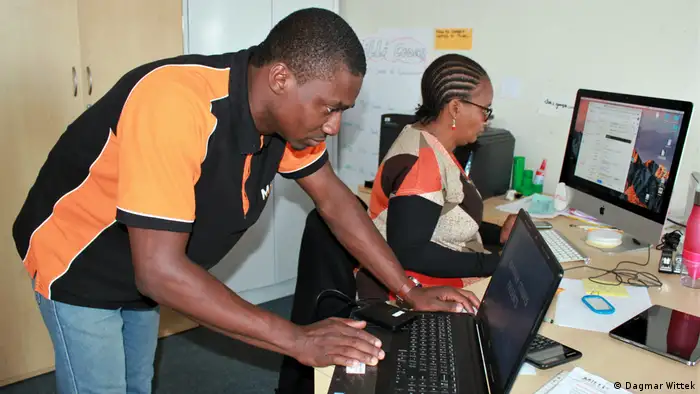Approach: Media and Information Literacy
Media and Information Literacy programs provide fact-checking skills
Many fact-checkers train others in verification methods through Media and Information Literacy programs. These make use of fact-checkers' expertise, enhance their public standing, and sometimes provide crucial funds.
What is Media and Information Literacy (MIL)?
Fact-checkers don't just check facts – they also train others to verify information for themselves. Such training often takes the form of Media and Information Literacy programs which equip audiences with their own tools for critically engaging with media.
Media and Information Literacy (MIL) encompasses a range of activities within the field of media development. MIL is defined primarily by its aims, which focus on empowering citizens to access, analyze, create, and reflect on media in order to claim their rights to free information and expression. UNESCO encourages policymakers to regard MIL as a "composite concept" which applies to different information providers (broadcast, print, social, and other media) and which fosters both technical skills and critical engagement.
MIL aims align closely with the work of fact-checkers, who seek to promote and improve information accuracy. Indeed, many fact-checking outlets operate training programs that allow them to share the techniques, knowledge, and experiences of their day-to-day work with others. At the same time, these projects enhance the public profile of organizations and help build trust in their work.
The fact-checkers at Georgia's Myth Detector have developed training programs for audiences ranging from the general public to school teachers and university students. They also share some of the resources they have developed for these training programs online. Their MIL Lab website makes available games, detailed case studies, and exercises related to topics such as "propaganda and verification," "media and information," among others.
Training programs can also be a source of revenue to support fact-checking operations. The commercial Agência Lupa runs online and in-person workshops for companies, government entities, and schools through its LupaEducação program. Africa Check, a non-profit, also offers fee-based courses in fact-checking focused on crime, health, education, and public opinion, among others.
While much MIL work is aimed at the general public, some fact-checkers target specific audiences that can act as multipliers. For example, First Draft News has developed techniques, tools, and training for journalists as part of its mission "to empower societies with accurate information in critical moments." Its website offers resources ranging from Essential Guides in PDF format to online courses on "Advanced Verification" or "Covering Coronavirus." The courses include short videos, case studies, and reading lists for self-directed study.
What kinds of misinformation does this approach most effectively address?
Many online resources and training programs produced by fact-checkers help media users to identify misinformation in digital form. For example, they teach users how to determine where a photo was taken, to spotsigns of manipulated video, or to find out information about dubious websites.
What are the advantages of this approach?
MIL represents a comprehensive approach that goes beyond checking individual claims, allowing fact-checkers to transfer their knowledge and skills directly to others. MIL projects involve taking a step back from everyday operations and explaining how fact-checking, journalism, and media systems work.
What are some of the challenges for this approach?
Like fact-checking generally, MIL projects can encounter difficulties reaching beyond interested audiences that are already knowledgeable and critically engaged. Partnerships with schools enable fact-checkers to address a cross-section of the general public, but one that rarely includes adults.
MIL is a broad field and some worry that programs focused too narrowly on fact-checking techniques can omit equally important aspects such as fostering democratic engagement or knowledge of media systems. Others argue that policies focused on educating individuals, while decidedly welcome, are no substitute for media regulation and collective decision-making.
How does it compare to other approaches?
Media and Information Literacy gets at the core of what most fact-checkers are trying to achieve: developing informed and critical citizens. As such, it complements fact-checking generally and can profit from the specific skill sets associated with other approaches, such as investigative fact-checking or the development of automated technologies.
What are some examples of best practice?
First Draft News' training resources and Verification Toolbox;
UNESCO's Journalism, 'Fake News' and Disinformation handbook;
resource collections of Global Investigative Journalism Network and Journalist's Toolbox;
the free, multilingual Verification Handbook.
Nuts and Bolts
Costs: higher in terms of time than money; a natural side project for many organizations;
Funding: training programs are a source of revenue for many independent outlets; MIL and other knowledge transfer projects are often also eligible for grant funding;
Topics: tailored to audience interests, focusing primarily on skill sets;
Inputs: knowledge and experience of verification techniques;
Outputs: workshops, courses and curricula, online resource collections.
WWW links
- Date 17.07.2020
- Author Andrew Tompkins
- Feedback: Send us your feedback.
- Print Print this page
- Permalink https://p.dw.com/p/3ejM3
- Date 17.07.2020
- Author Andrew Tompkins
- Send us your feedback.
- Print Print this page
- Permalink https://p.dw.com/p/3ejM3

